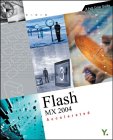 Flash MX 2004 Accelerated is the second of the Accelerated books I’ve seen from Sybex’s new series. The book does not have a single author but is by a Korean team called Youngjin. For full color guides with an included CD, the US $29.99 price on these books is quite reasonable.
Flash MX 2004 Accelerated is the second of the Accelerated books I’ve seen from Sybex’s new series. The book does not have a single author but is by a Korean team called Youngjin. For full color guides with an included CD, the US $29.99 price on these books is quite reasonable.
Some of the books I’ve reviewed with exercises on a CD offer up less than exciting files as the book’s practice exercises. This book, however, provides skillfully made and interestingly done exercise files, a big plus for the book that seems to indicate that the book’s creators know what they are doing. Much of what is used for practice is related to some of the new features of Flash MX 2004 such as the new timeline effects. Experienced Flash users could head straight for that material and get a quick look at the new tools. I found the descriptions of the tools and techniques brief but effective. The book covers the normal Flash animation techniques such as tweening and symbol use and further includes ActionScript, Behaviors, Movie Clips, Sound and Video, and Publishing. I found the exercises about importing Illustrator files and PDF and ESP file support very interesting.
I have the same complaint about the screen shots used to illustrate certain points in this text that I had with the Dreamweaver MX 2004 Accelerated I reviewed earlier, and that is that certain points could have been better made by zooming in on a menu or icon instead of expecting users to read them as a tiny element on the whole Flash stage. This book does at least mention accessibility: there is a 28 word paragraph about the Accessibility Panel in the description of the Flash interface. When describing the new support for CSS in Flash MX 2004, the example CSS provided listed anchor selectors in this order: a:link, a:active, a:visited, a:hover. Anyone depending on this example to set up link colors and states would soon be having problems, since the correct order should be a:link, a:active, a:hover, a:visited, or L-V-H-A. Another exercise had users create a scrolling text box using a Scroll Bar Component that is no longer included in Flash MX 2004 but was supplied on the accompanying CD. Now, perhaps this was done to illustrate the fact that components could be imported from elsewhere, but if that is the case, it certainly was not explained. The text is completely Windows-centric. Mac keyboard commands and other Mac interface differences were never mentioned.
Although I have used Flash, I haven’t taught a Flash class, so I don’t have strong opinions about how it should be done properly. I would like to hear from multimedia instructors out there about whether they think this book should be a recommended teaching text.
 Dreamweaver MX 2004 Accelerated
Dreamweaver MX 2004 Accelerated